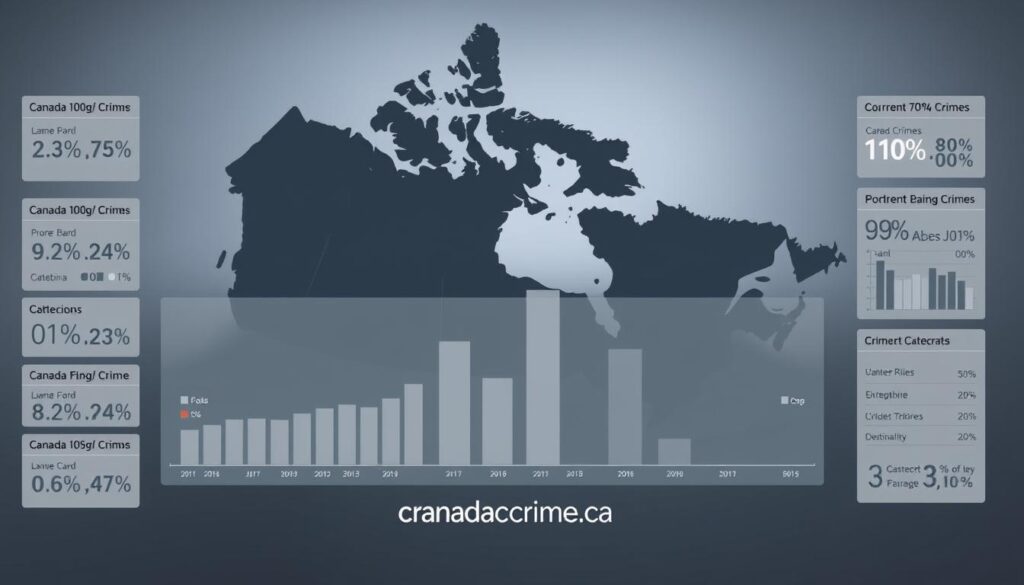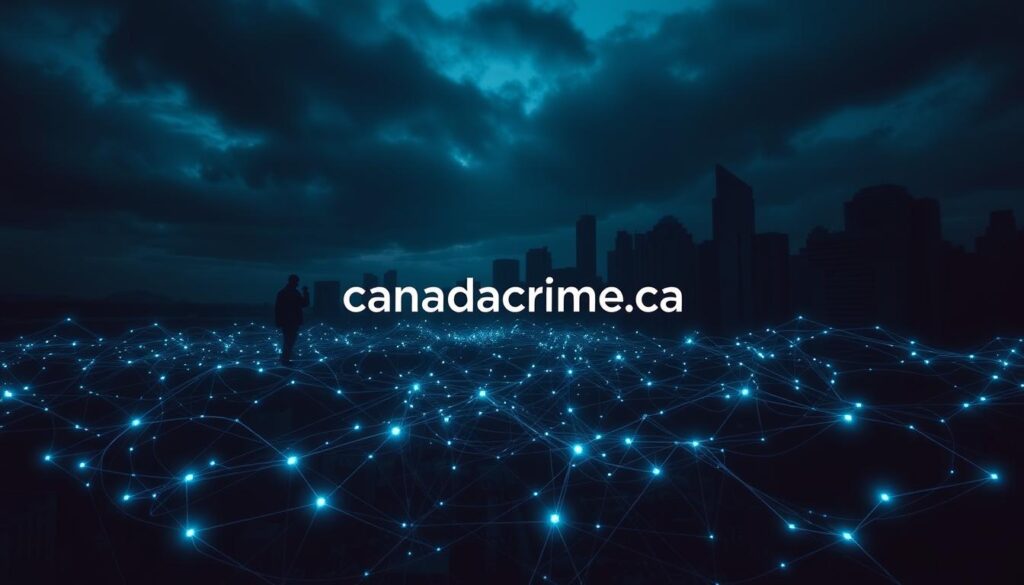Every 14 minutes, law enforcement intercepts illegal activities tied to sophisticated networks operating nationwide. These groups generate over $10 billion annually, according to canadacrime.ca, infiltrating everything from local businesses to digital spaces.
Major cities like Toronto and Montreal face unique challenges. Criminal operations adapt faster than ever, leveraging technology to evade detection. Calgary’s rapid growth has also made it a hotspot for emerging threats.
This isn’t just a law enforcement issue. Families, schools, and small businesses feel the ripple effects daily. The financial toll? Over $50 million yearly in community recovery programs alone.
You’ll discover how these networks operate, their evolving tactics, and what experts recommend for protection. Real data from government reports and frontline agencies will show patterns you might recognize in your own neighborhood.
Key Takeaways
- Major urban centers drive shifts in illegal activities nationwide
- Financial impacts extend far beyond direct victims
- Law enforcement strategies adapt to digital-age challenges
- Public resources like canadacrime.ca track real-time developments
- Community awareness reduces personal risk exposure
Overview of Organized Crime in Canada
From bustling ports to suburban neighborhoods, illegal networks shape financial flows and community safety nationwide. These operations funnel billions through money laundering schemes while moving illicit goods via sophisticated trafficking routes. British Columbia’s real estate markets and casinos often serve as hubs for washing dirty money, while cross-province drug pipelines fuel violence.

Defining the Scope of Crime Trends
You’ll find outlaw motorcycle gangs controlling rural territories and tech-savvy groups exploiting crypto markets. The law adapts through updated legislation like British Columbia’s unexplained wealth orders, targeting hidden assets. Yet criminal enterprises evolve faster—some mimic legitimate businesses while others weaponize dark web anonymity.
Three factors drive today’s threats:
- Global demand for opioids and synthetic drugs
- Digital payment systems enabling hidden transactions
- Weak spots in border security and financial regulations
Historical ties between smuggling routes and modern distribution networks reveal patterns. For real-time updates on trafficking hotspots or money laundering cases, visit canadacrime.ca. Their interactive maps show how these issues touch every province—including your region.
Historical and Current Crime Trends in Canada
Over the past 50 years, illicit networks have shifted tactics as quickly as technology evolves. The 1980s saw street-level drug operations dominate cities, while today’s schemes blend dark web marketplaces with corporate-style structures. Current patterns reveal how historical strategies inform modern threats.

Evolution Over the Decades
Early operations relied on physical control of territories. Motorcycle gangs ruled highways, while smuggling rings exploited weak border checks. By the 2000s, groups adopted digital tools—encrypted communications replaced coded letters, and cryptocurrency enabled hidden transactions.
Three key transformations stand out:
- Shift from localized operations to global supply chains
- Adoption of legal business fronts for money flows
- Increased collaboration between previously rival factions
Modern-Day Challenges
Law enforcement now combats AI-driven fraud and ransomware attacks. A 2023 police report shows 63% of investigations involve digital evidence—up from 12% in 2010. Groups exploit legal loopholes faster than regulations adapt.
| Era | Methods | Enforcement Tools |
|---|---|---|
| 1980s | Cash transactions | Surveillance teams |
| 2000s | Offshore accounts | Financial tracking |
| 2020s | Crypto wallets | Blockchain analysis |
Recent Criminal Intelligence Service Canada data highlights synthetic drug production as today’s fastest-growing threat. Their latest findings confirm urban labs now outnumber rural operations 3-to-1—a complete reversal from 1990s trends.
Investigating organized crime in canada: Methods and Networks
Modern investigators face operations that mirror corporate enterprises in complexity. These groups use layered structures to hide leadership while moving drugs and money through seemingly legitimate channels. A 2023 Calgary case revealed synthetic opioids shipped via food delivery trucks—one of many creative distribution tactics.

Networks and Group Dynamics
Decentralized cells now dominate illegal activities. Members often handle single tasks—like recruiting drivers or managing crypto wallets—to limit exposure. “You’re not chasing individuals anymore,” explains an Edmonton financial crimes detective. “You’re dismantling ecosystems.”
Three factors complicate these cases:
- Shared resources between rival factions
- Fake invoices masking laundering operations
- Burner phones resetting communication networks weekly
Investigative Techniques in Action
Forensic accountants track suspicious transactions through car dealerships and rental properties. Toronto police recently froze $12 million in assets tied to a vitamin supplement front moving fentanyl. Teams combine traditional surveillance with AI tools that flag irregular payment patterns.
Real-time updates from canadacrime.ca help investigators spot emerging drug routes. The site’s 2024 report shows 41% of money trails now involve digital art sales—a shift from last year’s casino-focused laundering schemes.
Regional Perspectives: Major Cities and Their Crime Dynamics
Urban centers and rural towns face distinct challenges when tackling illegal networks. Calgary saw 1,200 gang-related incidents last year—triple Edmonton’s reported number. These cities battle auto theft rings and synthetic drug labs, while smaller communities grapple with cross-border smuggling routes.

Calgary, Edmonton, and Beyond
Western hubs face unique pressures. Calgary’s 34% spike in financial fraud cases links to individuals exploiting oil industry supply chains. Edmonton’s task forces dismantled 17 trafficking cells in 2023—most disguised as delivery services. Rural Alberta towns report fewer incidents but face meth distribution networks targeting vulnerable people.
Insights from Montreal and Toronto
Eastern metros reveal different patterns. Montreal’s port handles 60% of seized contraband nationwide, while Toronto’s real estate market hides complex money trails. A recent case involved 12 individuals laundering profits through Ontario cannabis stores. Both cities use heat maps at canadacrime.ca to track emerging hotspots.
Crime in Smaller Communities
Quieter regions aren’t immune. Northern Ontario saw a 91% jump in cyber fraud targeting seniors last year. Coastal towns face unique threats—Nova Scotia’s fishing docks now monitor for smuggled opioids. The scope varies, but impacts hit harder where resources are scarce.
Key differences emerge when comparing regions:
- Urban areas: Higher incident numbers, tech-driven schemes
- Small towns: Lower visibility, resource limitations
- Coastal/remote zones: Cross-border trafficking risks
For hyperlocal data on how these trends affect your area, explore interactive tools at canadacrime.ca. Their 2024 regional breakdowns show which threats are growing fastest near you.
Community Impact and Local Governance Measures
Empty playgrounds and shuttered storefronts tell part of the story. Illicit networks drain $3.2 billion annually from neighborhoods through extortion and predatory loans, according to canadacrime.ca. Families face impossible choices when these groups infiltrate local housing or youth programs.
Effects on Neighborhoods and Families
You’ll find three social costs hitting hardest:
- Mental health crises doubling in areas with active operations
- School dropout rates rising 22% near trafficking hubs
- Local businesses closing at twice the national average
The Intelligence Service Canada reports 143 community-led projects disrupting these patterns last year. Indigenous groups in Manitoba reduced gang recruitment by 40% through cultural mentorship programs. “We rebuilt trust street by street,” shares a Winnipeg organizer.
Local organizations now use real-time maps from criminal intelligence service teams to target resources. Vancouver’s Downtown Eastside saw assaults drop 31% after installing motion-activated lights in high-risk alleys. These wins prove coordinated efforts work.
Your next door neighbor might be part of the solution. Visit canadacrime.ca to find neighborhood watch tools and financial literacy workshops. Small actions create ripple effects that starve organized crime groups of their power base.
Law Enforcement Strategies and Government Response
Canadian authorities now disrupt major operations weekly through coordinated raids and data analysis. Law enforcement teams combine cyber forensics with financial audits to dismantle crime groups from multiple angles. Last year’s Project Coyote froze $47 million in assets linked to cross-border smuggling rings—a tactic highlighted on canadacrime.ca’s enforcement case studies.

Enforcement Tactics and Policy Interventions
New laws empower officers to track crypto transactions and seize suspicious properties faster. “We’re hitting them where it hurts—their wallets and their networks,” says a Toronto financial crimes unit leader. Recent policy updates require banks to flag patterns matching human trafficking payment methods.
Three key changes show results:
- Mandatory training for border agents to spot recruitment victims
- Stiffer penalties for laundering through legitimate businesses
- Real-time data sharing between provincial and federal agencies
Collaborative Initiatives with Local Agencies
Service Canada coordinates 22 task forces targeting drug distribution hubs and fraud rings. A Winnipeg initiative combined police patrols with social workers to reduce gang recruitment by 18% in six months. canadacrime.ca tracks these joint efforts through their monthly enforcement digest.
Stay informed using these resources:
- Subscribe to regional threat alerts via text
- Attend virtual town halls with law enforcement experts
- Use interactive maps showing active investigations near you
International Partnerships and Cross-Border Collaborations
Global partnerships form invisible shields against transnational threats. The Canada-U.S. Cross Border Crime Forum demonstrates how shared strategies combat drug trafficking networks spanning both nations. Last year’s Operation Shadow dismantled a fentanyl pipeline using real-time criminal intelligence from six agencies.

Cooperation with U.S. and Global Agencies
You’ll find three critical tools driving success:
- Joint cyber task forces tracking dark web transactions
- Standardized evidence-sharing protocols across borders
- Multinational asset freezing agreements
The intelligence service consortium Five Eyes shares 78% more data today than in 2019. This shift helps intercept shipments before they reach communities. Recent seizures at Windsor-Detroit crossings prove these systems work.
| Collaboration Type | Key Focus | Results (2023) |
|---|---|---|
| Joint Task Forces | Weapon smuggling | 142 arrests |
| Intelligence Sharing | Cryptocurrency tracking | $89M recovered |
| Tech Initiatives | Dark web monitoring | 31 markets closed |
Global strategies strengthen local defenses. Montreal police recently used Europol data to bust a car theft ring within hours. Visit canadacrime.ca for live updates on international operations affecting your region.
These partnerships tackle organized criminal groups exploiting legal gaps between nations. Through the intelligence service network INTERPOL, Canadian officers now train with counterparts in 14 countries. Their collective efforts reduce threats faster than any single nation could achieve alone.
Financial Crimes: Money Laundering and Fraud in Canada
Canada’s financial systems face silent threats from sophisticated schemes moving dirty money through everyday businesses. Recent data shows $1.5 billion laundered annually via Vancouver real estate—a gateway for gangs to legitimize profits from drug sales and cyber scams.

Money Laundering Schemes Explored
You’ll find three common tactics reshaping the country’s economic landscape:
- Fake invoicing through construction companies and car dealerships
- Cryptocurrency “mixers” obscuring transaction trails
- Trade-based laundering using overpriced exports
Toronto police recently uncovered a network using food trucks to cycle cash from illegal gambling. Their report on canadacrime.ca reveals how 63% of seized assets involved multiple provinces.
Fraudulent Activities and Investigations
Enforcement teams now track digital footprints across borders. A Montreal case saw 19 arrests after a fake tech startup siphoned $12 million through 14 countries. Investigators used AI tools to map connections between shell companies and known gang affiliates.
| Method | Enforcement Countermeasure | 2024 Cases |
|---|---|---|
| Real Estate Layering | Unexplained Wealth Orders | 47 |
| Phantom E-Commerce | Blockchain Analysis | 29 |
| Charity Fraud | Donation Audits | 14 |
Fraud reports spiked 300% in Calgary last year—many targeting seniors through romance scams. canadacrime.ca offers free fraud detection toolkits to help you spot red flags. Their live tracker shows how financial crimes impact every postal code.
Cybercrime and Emerging Digital Threats
Cyberattacks now strike Canadian businesses every 11 seconds, reshaping how criminals exploit digital vulnerabilities. This article reveals how ransomware gangs and fraud networks exploit global connections—and what you can do to stay protected.
The Rise of Ransomware Attacks
Hospitals, schools, and corporations face relentless digital extortion. Attackers encrypt critical data and demand payments in untraceable cryptocurrencies. A 2024 report shows 78% of Canadian ransomware cases involve actors from multiple countries.
| Target Sector | Average Demand | Recovery Rate |
|---|---|---|
| Healthcare | $1.4M | 43% |
| Manufacturing | $890K | 61% |
| Local Government | $2.1M | 29% |
Digital Fraud and Cybersecurity Challenges
Scammers now mimic trusted brands through phishing emails and fake websites. Law enforcement struggles to track funds moved across 14+ nations in minutes. “We’re fighting algorithms with algorithms,” notes a cybercrime investigator from the RCMP’s National Division.
Three steps reduce your risk:
- Enable multi-factor authentication on all accounts
- Verify unusual payment requests via separate channels
- Monitor canadacrime.ca for active fraud alerts
Global digital trade systems create new attack surfaces. Recent cases show criminals exploiting shipping logistics software to reright cargo. Stay ahead of threats by subscribing to real-time updates at canadacrime.ca—your frontline defense against evolving cyber risks.
Case Studies: Real-Life Crime Incidents Across Canada
Toronto’s Pearson Airport intercepted 48kg of fentanyl last month hidden in children’s toys—a grim example of how criminal networks operate. These incidents reveal patterns that shape community safety nationwide. Below, we analyze high-profile cases using data from canadacrime.ca to show their ripple effects.
Notable Incidents in Toronto
A 2023 drug pipeline case exposed members of a transnational group using food delivery apps to distribute meth. Police tracked 127 encrypted messages linking suppliers to local dealers. “This wasn’t just about substances—it funded other dangerous activities,” stated Detective Amir Khan during the trial.
Montreal’s Evolving Crime Wave
The city’s port remains a hotspot for contraband. Last year, authorities found cocaine worth $9 million inside industrial machinery from South America. Criminal tactics shifted after 2022 legislation—recent reports show a 40% increase in cyber-enabled fraud targeting small businesses.
Violent Confrontations in Other Cities
Calgary saw a daylight shooting tied to territory disputes between rival groups. Bodycam footage revealed traffickers using stolen vehicles modified with hidden compartments. Winnipeg’s task forces dismantled 14 synthetic drug labs in 2024 alone—many operated by youth recruited through social media content.
Key lessons from these cases:
- Monitor local shipping hubs for unusual activities
- Report suspicious financial transactions immediately
- Use canadacrime.ca’s incident map to identify emerging threats
Preventive Measures and Public Education Initiatives
Preventing illegal networks starts with empowered communities and smart resource allocation. Local groups now use interactive tools from canadacrime.ca to identify risks and share real-time alerts. These efforts build a protective system that stops threats before they escalate.
Role of Community Awareness Programs
Neighborhood watch initiatives reduced break-ins by 34% in Toronto districts last year. Programs like “Eyes on the Street” teach residents to spot suspicious patterns—unusual vehicle traffic or sudden property changes. Vancouver’s Cultural Safety Network pairs newcomers with mentors to avoid exploitation traps.
Three elements make these efforts successful:
- Regular safety workshops in schools and community centers
- Anonymous reporting tools protecting whistleblowers
- Partnerships between local groups and law enforcement
| Program | Key Focus | Impact |
|---|---|---|
| Block Ambassador | Resident-led patrols | 27% fewer thefts |
| Fraud Fighters | Senior scam prevention | 1,200+ cases reported |
| Youth Shield | Gang recruitment resistance | 41% drop in memberships |
Support systems for victims break cycles of fear. Winnipeg’s Restorative Justice Circles connect affected families with counselors and legal aid. Montreal’s Safe Harbor initiative provides temporary housing for those fleeing exploitation.
Your local library or recreation center likely hosts free prevention workshops. Visit canadacrime.ca to find programs in your place—many offer childcare and translation services. Small actions like attending one session strengthen entire neighborhoods against emerging threats.
Conclusion
Understanding criminal networks requires recognizing their impact on daily life and national systems. From digital fraud to neighborhood safety risks, these activities strain community resources and demand coordinated responses. Recent cases like the Ontario rental scam show how easily individuals exploit trust for profit.
Government efforts play a critical role. Updated policies now freeze suspicious assets faster and track cross-border money flows. Law enforcement agencies use AI tools to map hidden connections between illegal operations and legitimate businesses.
Your awareness matters. Proactive measures—like verifying rental agreements or monitoring financial transactions—reduce personal risks. Communities that share real-time data through platforms like canadacrime.ca see faster threat detection and reduced vulnerability.
Stay informed about evolving activity patterns. Visit canadacrime.ca for interactive maps showing emerging hotspots and prevention strategies. Together, public vigilance and government action create stronger defenses against complex threats.

